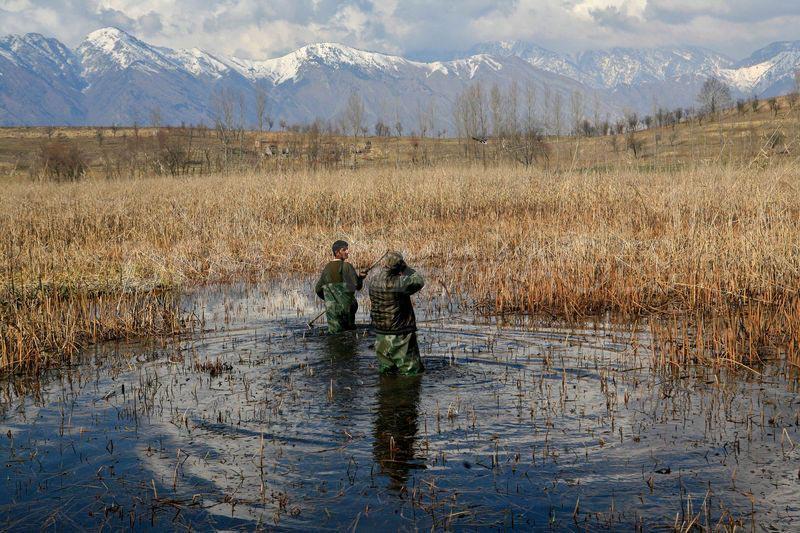Kashmir Watches An Ancient Hydraulic System Slip Away
Representational Photo
By Sibtain Shafi
In the first week of September this year, rain began over Srinagar as a slow, dark evening drizzle and soon thickened into a relentless sheet that drummed on streets.
Rooftops rattled under the pounding water. Lights reflected in puddles that grew into streams along alleys. Houseboats on the Jhelum bobbed and groaned.
Ashiq Ahmad, a man who has lived on the river all his life, stood on his deck, tying ropes to a sagging poplar and moving furniture to higher floors.
“The water should have spread into the marshes,” he said, his eyes fixed on the black surface climbing the moorings.“Now it comes straight for us.”
It came all night. Side streams overflowed, and the Jhelum crept over its banks. Between August 22 and September 4, Srinagar received nearly three times its usual rainfall. The next week, more than three and a half times the normal amount fell.
By mid-August, floods and landslides had claimed sixty lives and left more than two hundred people missing across Jammu and Kashmir.
The valley had once managed such rains differently. A network of lakes, marshes, and floodplains acted as sponges. Dal, Wular, Anchar, and dozens of smaller marshes absorbed torrents, filtered sediments, and released water slowly back into the Jhelum.
That network is breaking apart, piece by piece.
Government records are stark. Jammu and Kashmir's wetland area fell from about 391,500 hectares in 2011 to 164,110 hectares in 2021. Dal Lake has lost a quarter of its open water since 1980. Wular, once Asia's largest freshwater lake, shrank from nearly 20,000 hectares to barely 2,400. Anchar Lake is down from 19.4 square kilometres to 6.8.
Around Srinagar, the changes are visible. Floodplains have been paved, drainage channels filled or walled, and the Jhelum runs narrower and silted, hemmed by concrete.
Upstream, forests have been cut, hillsides scarred by quarries, roads carve through slopes, and loose soil now rushes straight to the rivers.
A 2019 study by University of Kashmir researchers warned that these changes had crippled the valley's natural flood cushion. Neighbourhoods now sit on marshes that used to drain slowly.
The impact is in daily life. Nine major wetlands failed water-quality standards last year, contaminated by sewage and low oxygen. Traditional wells and springs are drying, and families depend on tanker trucks or irregular piped water. Farmers report erratic irrigation. Fishermen speak of dwindling catches in weed-choked waterways. Nadru, the lotus stem harvested for local cuisine, has nearly vanished.
“We used to fill boats with lotus every autumn,” said Naseem Begum, a former harvester at Anchar Lake.“Now the marsh is silted and empty.”
The geography compounds the problem. Srinagar sits in a bowl-shaped depression. Floodwaters that once spread into marshes now surge directly into homes and stay for days.
“We are dismantling a hydraulic system we barely understood,” said Dr. Farooq Rashid, a Srinagar-based ecologist.“Every wetland lost removes another layer of protection. Without urgent restoration, heavier rains will bring heavier disasters.”
Some restoration has begun. At Wular Lake, millions of cubic metres of silt and over two million invasive willows have been removed, and lotus flowers are returning. Work at Hokersar and Hygam has reopened clogged channels. Local harvesters are replanting lotus.

Legal Disclaimer:
MENAFN provides the
information “as is” without warranty of any kind. We do not accept
any responsibility or liability for the accuracy, content, images,
videos, licenses, completeness, legality, or reliability of the information
contained in this article. If you have any complaints or copyright
issues related to this article, kindly contact the provider above.
Most popular stories
Market Research

- Kintsu Launches Shype On Hyperliquid
- Barunson, Studio Behind Parasite, To Launch Nplug IP Remixing Platform On Story And Bring Flagship IP Onchain
- Moonbirds And Azuki IP Coming To Verse8 As AI-Native Game Platform Integrates With Story
- Leverage Shares Launches First 3X Single-Stock Etps On HOOD, HIMS, UNH And Others
- Alchemy Markets Launches Tradingview Integration For Direct Chart-Based Trading
- Dexari Unveils $1M Cash Prize Trading Competition






















Comments
No comment